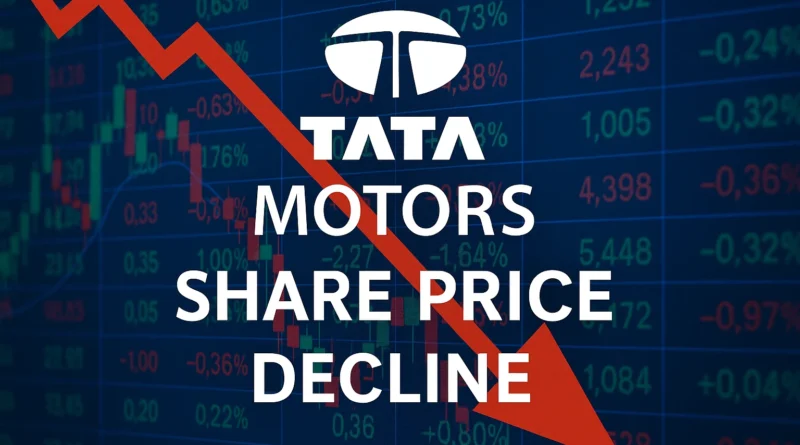Tata Motors Stock Plunges as JLR Outlook Dampens Investor Sentiment Amid Tariff Fears
MUMBAI, INDIA – Shares of Tata Motors (NSE: TATAMOTORS) experienced a significant decline on Monday, June 16, 2025, tumbling more than 5% in early trade. The sharp downturn was primarily triggered by a weaker-than-expected financial outlook for FY26 from its British luxury vehicle subsidiary, Jaguar Land Rover (JLR), compounded by growing concerns over geopolitical trade tensions and new US tariffs on automobile imports.
As of Monday afternoon, Tata Motors stock was trading around ₹685.35, down approximately 3.76% from its previous close of ₹712.05. This recent slide contributes to a broader negative trend, with the stock having fallen around 13% in the last six months and approximately 30% over the past 12 months, placing it 42% below its 52-week high of ₹1,179.05. The current market capitalization stands at approximately ₹2.52 Lac Crore.
JLR’s Revised Outlook Weighs Heavily
The primary catalyst for today’s sell-off is JLR’s revised earnings before interest and taxes (EBIT) margin guidance for FY26. The company now expects EBIT margins to range between 5% and 7%, a substantial downgrade from its previously targeted 10%. For context, JLR reported an EBIT margin of 8.5% in FY25. This revised outlook signals significant headwinds for the crucial subsidiary, which accounted for approximately 71% of Tata Motors’ consolidated revenue and 80% of its profitability in FY25.
Tata Motors’ management has cited rising input costs, ongoing chip shortages, and macroeconomic pressures in key markets such as the US and Europe as factors contributing to the muted forecast. Analysts, however, emphasize that the looming US import tariffs, particularly a 25% duty on foreign-made vehicles, pose the biggest threat, directly impacting JLR’s export margins and demand. JLR has reportedly paused shipments to the United States due to these tariff concerns. Furthermore, JLR expects its free cash flow to decline to near zero in FY26, a significant drop from £1.5 billion in FY25, although management remains optimistic about improving cash flow in FY27 and FY28.
Analyst Sentiment and Recent Financials
Analyst sentiment is mixed, leaning towards caution. Kotak Institutional Equities maintained a “SELL” rating on Tata Motors with a fair value target of ₹600, noting that tariff-related risks are not yet fully factored into current valuations. Motilal Oswal Financial Services adopted a more “NEUTRAL” stance with a target price of ₹690, highlighting execution challenges amid a weak demand environment for both Commercial Vehicles (CV) and Passenger Vehicles (PV) segments, coupled with mounting cost pressures. The consensus price target from various analysts stands at ₹792.67, implying an 11.32% upside from current levels, but the recent downgrade from JLR suggests a re-evaluation might be underway.
In its Q4 FY25 results (ended March 2025), released on May 13, 2025, Tata Motors reported a sharp 51.34% year-on-year decline in consolidated net profit to ₹8,470 crore, compared to ₹17,407 crore in the same period last fiscal. Despite this, consolidated revenue from operations saw a marginal increase of 0.4% to ₹1,19,503 crore. The weak profitability was largely attributed to JLR’s performance and rising cost pressures. For the full FY25, the company reported record revenues of ₹4,39,695 crore, with the automotive business turning net cash positive.
Outlook for Investors and Traders
The immediate future for Tata Motors stock appears challenging, primarily due to the revised JLR outlook and the uncertainty surrounding global trade policies, particularly US tariffs. While the company has ambitious targets for its CV and PV segments and is focusing on strategic initiatives like expanding its EV portfolio and launching new models (e.g., Harrier EV with a 627km range), execution in a demanding market will be key. Investors and traders should closely monitor geopolitical developments, particularly regarding tariffs, as well as JLR’s performance and any further updates from the company’s management. The volatility of the stock, with a beta coefficient of 1.35, suggests it will be sensitive to market shifts.
